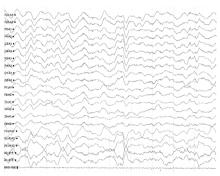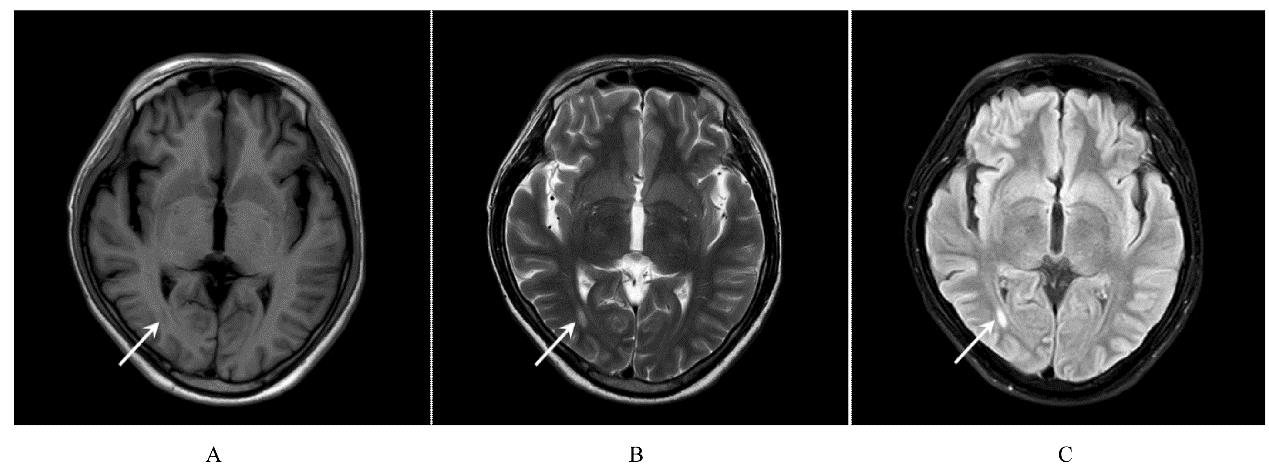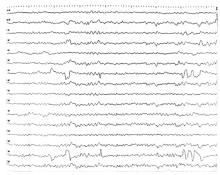| 1 |
李 想, 何志义. 病毒性脑炎继发自身免疫性脑炎的研究进展[J]. 中国临床神经科学, 2020, 28(5): 584-589, 594.
|
| 2 |
BRADSHAW M J, VENKATESAN A. Herpes simplex virus-1 encephalitis in adults: pathophysiology, diagnosis, and management[J]. Neurotherapeutics, 2016, 13(3): 493-508.
|
| 3 |
DALMAU J, TÜZÜN E, WU H Y, et al. Paraneoplastic anti-N-methyl-D-aspartate receptor encephalitis associated with ovarian teratoma[J]. Ann Neurol, 2007, 61(1): 25-36.
|
| 4 |
ARMANGUE T, LEYPOLDT F, MÁLAGA I, et al. Herpes simplex virus encephalitis is a trigger of brain autoimmunity[J]. Ann Neurol, 2014, 75(2): 317-323.
|
| 5 |
ARMANGUE T, SPATOLA M, VLAGEA A, et al. Frequency, symptoms, risk factors, and outcomes of autoimmune encephalitis after herpes simplex encephalitis: a prospective observational study and retrospective analysis[J]. Lancet Neurol, 2018,17(9): 760-772.
|
| 6 |
李务荣, 高俊华, 姜美娟, 等. 抗神经元细胞表面抗原抗体相关自身免疫性脑炎7例临床分析[J]. 中国神经免疫学和神经病学杂志, 2018, 25(1): 32-36.
|
| 7 |
毛丹丹, 胡文广, 刘 平, 等. 儿童单纯疱疹病毒脑炎合并抗NMDAR和抗Hu抗体双重阳性自身免疫性脑炎的临床特点(附1例报告)[J]. 中国神经免疫学和神经病学杂志, 2022, 29(3): 211-215.
|
| 8 |
冯绵烨, 娄 燕. 病毒性脑炎的诊治研究进展[J]. 中华诊断学电子杂志, 2019, 7(1): 66-70.
|
| 9 |
SCHLEEDE L, BUETER W, BAUMGARTNER-SIGL S, et al. Pediatric herpes simplex virus encephalitis: a retrospective multicenter experience[J]. J Child Neurol, 2013, 28(3): 321-331.
|
| 10 |
SKÖLDENBERG B, AURELIUS E, HJALMARSSON A, et al. Incidence and pathogenesis of clinical relapse after herpes simplex encephalitis in adults[J]. J Neurol, 2006, 253(2): 163-170.
|
| 11 |
HÖFTBERGER R, ARMANGUE T, LEYPOLDT F, et al. Clinical neuropathology practice guide 4-2013: post-herpes simplex encephalitis: N-methyl-daspartate receptor antibodies are part of the problem[J]. Clin Neuropathol, 2013, 32(4): 251-254.
|
| 12 |
TITULAER M J, LEYPOLDT F, DALMAU J. Antibodies to N-methyl-D-aspartate and other synaptic receptors in choreoathetosis and relapsing symptoms post-herpes virus encephalitis[J].Mov Disord, 2014, 29(1): 3-6.
|
| 13 |
PRÜSS H. Postviral autoimmune encephalitis: manifestations in children and adults[J]. Curr Opin Neurol, 2017, 30(3): 327-333.
|
| 14 |
NOSADINI M, MOHAMMAD S S, CORAZZA F, et al. Herpes simplex virus-induced anti-N-methyl-d-aspartate receptor encephalitis: a systematic literature review with analysis of 43 cases[J]. Dev Med Child Neurol, 2017, 59(8): 796-805.
|
| 15 |
MOHAMMAD S S, SINCLAIR K, PILLAI S, et al. Herpes simplex encephalitis relapse with chorea is associated with autoantibodies to N-Methyl-D-aspartate receptor or dopamine-2 receptor[J]. Mov Disord, 2014, 29(1): 117-122.
|
| 16 |
LINNOILA J J, BINNICKER M J, MAJED M, et al. CSF herpes virus and autoantibody profiles in the evaluation of encephalitis[J]. Neurol Neuroimmunol Neuroinflamm, 2016, 3(4): e245.
|
| 17 |
AL-ANSARI A, ROBERTSON N P. Autoimmune encephalitis: clinical presentation, investigation and treatment[J]. J Neurol, 2021, 268(10): 3935-3937.
|
| 18 |
李学斌, 杨 灿, 李秋波, 等. 抗N-甲基-D-天门冬氨酸受体脑炎病理机制的研究进展[J]. 中风与神经疾病杂志,2023,40(4): 382-384.
|
| 19 |
吴 燕, 苏志强, 丁婉秋. 抗γ氨基丁酸B受体脑炎研究进展[J].中国临床神经科学,2022,30(2):231-235.
|
| 20 |
ESPOSITO S, PRINCIPI N, CALABRESI P, et al. An evolving redefinition of autoimmune encephalitis[J]. Autoimmun Rev, 2019, 18(2): 155-163.
|
| 21 |
PRÜSS H, FINKE C, HÖLTJE M, et al. N-methyl-D-aspartate receptor antibodies in herpes simplex encephalitis[J]. Ann Neurol, 2012, 72(6): 902-911.
|
| 22 |
伍 妘, 张炜华, 吕俊兰, 等. 继发于单纯疱疹病毒性脑炎的抗-N-甲基-D-天门冬氨酸受体脑炎4例病例报告[J]. 中国循证儿科杂志, 2014, 9(3): 223-226.
|
| 23 |
ALEXOPOULOS H, AKRIVOU S, MASTROYANNI S, et al. Postherpes simplex encephalitis: a case series of viral-triggered autoimmunity, synaptic autoantibodies and response to therapy[J]. Ther Adv Neurol Disord, 2018, 11: 1756286418768778.
|
| 24 |
高 煜, 王向波, 闫鹤立, 等. 呈典型双峰脑炎表型的单纯疱疹病毒脑炎继发自身免疫性脑炎[J]. 中国神经精神疾病杂志, 2021, 47(8): 449-454.
|
| 25 |
朱红敏, 孙 丹, 胡家胜, 等. 继发于单纯疱疹病毒性脑炎的儿童抗NMDAR脑炎合并抗GABABR脑炎一例报道[J]. 中华神经医学杂志, 2020, 19(1): 73-75.
|
| 26 |
赵宛玉, 杜敢琴, 张在行. 单纯疱疹病毒性脑炎继发抗NMDAR脑炎1例报道并文献复习[J]. 卒中与神经疾病, 2019, 26(1): 116-117.
|
| 27 |
曹 阳, 肖 能, 胡石腾, 等. 磁共振3D-ASL定量评估儿童病毒性脑炎脑灌注特征[J]. 中国医学物理学杂志,2022,39(4): 475-478.
|
| 28 |
中华医学会神经病学分会神经感染性疾病与脑脊液细胞学学组. 中国自身免疫性脑炎诊治专家共识(2022年版)[J]. 中华神经科杂志, 2022, 55(9): 931-949.
|
| 29 |
HÖFTBERGER R, TITULAER M J, SABATER L, et al. Encephalitis and GABAB receptor antibodies: novel findings in a new case series of 20 patients[J]. Neurology, 2013, 81(17): 1500-1506.
|
| 30 |
SAHAR N, NURRE A M, SIMON R Q. Infectious trigger for autoimmune encephalitis: a case report and literature review[J]. Case Rep Infect Dis, 2019, 2019: 5731969.
|
| 31 |
XU X L, LU Q, HUANG Y, et al. Anti-NMDAR encephalitis: a single-center, longitudinal study in China[J]. Neurol Neuroimmunol Neuroinflamm, 2020, 7(1): e633.
|
| 32 |
MCKAY J H, DIMBERG E L, LOPEZ CHIRIBOGA A S. A systematic review of Gamma-aminobutyric Acid Receptor Type B autoimmunity[J]. Neurol Neurochir Pol, 2019, 53(1): 1-7.
|
| 33 |
KIM S H, KIM W. GABA-B receptor encephalitis triggered by enterovirus encephalitis in a patient with small cell lung cancer: a case report[J]. Neurologist, 2020, 25(4): 106-108.
|
| 34 |
迟博闻, 王佳伟. 单纯疱疹病毒感染后自身免疫性脑炎的研究进展[J]. 首都医科大学学报, 2021, 42(3): 341-346.
|
 )
)
 )
)






